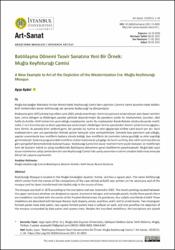| dc.contributor.author | Aydın, Ayşe | |
| dc.date.accessioned | 2021-07-02T07:28:18Z | |
| dc.date.available | 2021-07-02T07:28:18Z | |
| dc.date.issued | 2021 | en_US |
| dc.identifier.citation | Aydin, Ayse. “Batılılaşma Dönemi Tasvir Sanatına Yeni Bir Örnek: Muğla Keyfoturağı Camisi.” Art-Sanat, 15(2021):
1–34. https://doi.org/10.26650/artsanat.2021.15.0001 | en_US |
| dc.identifier.uri | https://doi.org/10.26650/artsanat.2021.15.0001 | |
| dc.identifier.uri | https://hdl.handle.net/20.500.12809/9364 | |
| dc.description.abstract | Muğla Karabağlar Mahallesi Yurtlar Mevkii’ndeki Keyfoturağı Camisi kare planlıdır. Caminin harim duvarlarındaki Ashâb-ı Kehf isimlerinden alınan Kehfoturağı adı zamanla Keyfoturağı’na dönüşmüştür. Kitabesine göre 1870 yılında inşa edilen cami 2005 yılında onarılmıştır. Harim üst pencere aralarında yer alan duvar resimleri kare, enine dörtgen ve dikdörtgen panolar şeklinde düzenlenmiştir. Bu panoların içinde Hz. Muhammed, torunları, dört halife ile Ashâb-ı Kehf isimlerinin yazılı olduğu madalyonlar vardır. Bu madalyonlar Barok-Rokoko üslubunda perde motifi, volüt, C ve S kıvrımlarıyla ve akant yapraklarıyla süslenmiştir. Dikdörtgen formlu panolardan ikisinin içinde hurma ağaçları, kare formlu iki panoda birer yelkenli gemi, bir panoda ise hurma ve selvi ağaçlarıyla birlikte cami tasviri yer alır. Yazılı madalyonların yanı sıra panolardan birinde yazılar kartuşlar içine yerleştirilmiştir. Zamanla bazı panoların yok olduğu, yapılan onarımlarda bazı motiflerin badana altında kaldığı, bazı motiflerin de üzerinden tekrar geçildiği ve ekler yapıldığı görülmektedir. Süsleme programındaki motiflere renkler kullanılarak ışık-gölge ile hacim verilmiş, Batı etkili resim kurallarına göre perspektif denemelerinde bulunulmuştur. Keyfoturağı Camisi’nin duvar resimleri hem seçilen konuları ve motifleriyle hem de bunların teknik ve üslup özellikleriyle Batılılaşma döneminin genel özelliklerini yansıtmaktadır. Muğla’daki sayılı duvar resimlerine sahip camilerden biri olan Keyfoturağı Camisi’nde yanlış onarımların izlerini ortadan kaldırmak amacıyla bilinçli bir çalışma yapılmalıdır. | en_US |
| dc.description.abstract | Keyfoturagi Mosque is located in the Mugla Karabaglar Quarter, Yurtlar, and has a square plan. The name Kehfoturagi which comes from the names of the companions of the cave (Ashab al-Kahf) was written on the sanctuary wall of the mosque and has been transformed into Keyfoturagi in the course of time.
The mosque was built in 1870 according to the inscription and was restored in 2005. The mural paintings located between the upper sanctuary windows are designed as square, transverse tetragon and rectangle panels. Inside these panels there are medallions inscribed with the names of the Prophet Muhammad, his grandsons, four caliphs and Ashab al-Kahf. These medallions are decorated with Baroque-Rococo style drapery, volute, acanthus, and C and S curved leaves. Two rectangular formed panels have date palms, two square formed panels have a sailboat on each, and one panelhas the depiction of the mosque surrounded by date palms and cypress trees. Besides the inscribed medallions, the inscriptions are placed within cartouches on one of the panels. It is apparent that some of the panels have vanished in the course of time, some motifs have been covered by whitewash during restorations, and some motifs have been retraced and appended. By using colour and chiaroscuro, volume is enhanced on the motifs of the decoration program and perspective trials have been made due to the western influenced drawing orders. The mural paintings of Keyfoturag.i Mosque reflect the general characteristics of the Westernization era both by their themes and motifs, and by their technical and characteristic features.
A deliberate study should be carried out in order to remove the traces of misguided restoration in Keyfoturagi Mosque which is a rare mosque having mural paintings in Mugla. | en_US |
| dc.item-language.iso | tur | en_US |
| dc.publisher | İstanbul Üniversitesi | en_US |
| dc.relation.isversionof | 10.26650/artsanat.2021.15.0001 | en_US |
| dc.item-rights | info:eu-repo/semantics/openAccess | en_US |
| dc.subject | Muğla-Keyfoturağı Camisi | en_US |
| dc.subject | Batılılaşma dönemi | en_US |
| dc.subject | Süsleme | en_US |
| dc.subject | Keyfoturagi Mosque | en_US |
| dc.subject | Ashab al-Kahf | en_US |
| dc.subject | Mural painting | en_US |
| dc.subject | Duvar Resmi | en_US |
| dc.subject | Ashâb-ı Kehf | en_US |
| dc.title | Batılılaşma Dönemi Tasvir Sanatına Yeni Bir Örnek: Muğla Keyfoturağı Camisi | en_US |
| dc.item-title.alternative | A New Example to Art of the Depiction of the Westernization Era: Mugla Keyfoturagi Mosque | en_US |
| dc.item-type | article | en_US |
| dc.contributor.department | MÜ, Edebiyat Fakültesi, Sanat Tarihi Bölümü | en_US |
| dc.contributor.authorID | 0000-0001-5944-6347 | en_US |
| dc.contributor.institutionauthor | Aydın, Ayşe | |
| dc.identifier.volume | 15 | en_US |
| dc.identifier.startpage | 1 | en_US |
| dc.identifier.endpage | 34 | en_US |
| dc.relation.journal | Art-Sanat | en_US |
| dc.relation.publicationcategory | Makale - Uluslararası Hakemli Dergi - Kurum Öğretim Elemanı | en_US |


















